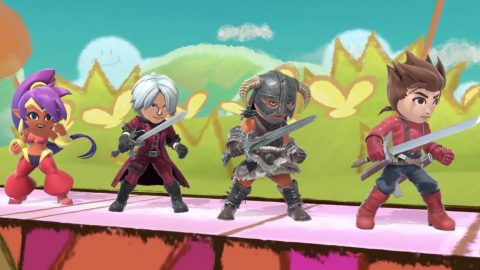
Yuito, one of the heroes of Scarlet Nexus, is struggling with his psychic abilities. Blessed with telekinetic power and networked together with the minds of his teammates, his brain is stretched to the limit. And as I play the game, I kind of know how he feels. Scarlet Nexus seems designed to overload your senses, memory and motor functions. It’s a game about synergy and mental energy that jacks you in to its world, electrifying and draining. But, like Yuito, I never want to quit. Sometimes it gets too much. Mostly it’s exactly what I signed up for.
In fact, for those of us who feel at home with Devil May Cry or Platinum Games titles like Bayonetta, there’s a level of comfort here. Scarlet Nexus feels like a Platinum game from a parallel universe, namely one in which 2019’s Astral Chain forked off in a new direction. It shares Astral Chain’s sharp, cel-shaded anime style and bouncing soundtrack. It similarly follows an elite government force exterminating monsters of unknown origin in a futuristic city. Most importantly, it has the same impossibly slick, kinetic, close quarter action, and expects you to quickly call on various powers to match the weaknesses of your foes.

Because the key to Scarlet Nexus isn’t just your own ability to levitate heavy objects and fling them at enemies’ heads, but the ‘Struggle Arms System (SAS)’ that links you to your squad and enables you to channel their powers too. Both protagonists, Yuito and Kasane, who you choose between at the start of the game, specialise in telekinesis, but each comes to lead a different squad of individuals with their own unique skills, from pyrokinesis and electrokinesis to clairvoyance and teleportation. Using these you might instantly buff your weapon with fire, reveal hidden enemies, and so on.
SAS is the inspired flourish atop a dense and polished core. Everything you might expect from this sort of game – air juggles, dodge counters, projectile deflects, finishing moves, a powered up super mode – is present and correct, and a skill tree piles on further possibilities as you level up, from air dashes to simultaneous power use. Not to mention additional telekinetic attacks linked to your surroundings – you might launch a train at your enemy, or possess a large statue and hammer them repeatedly from above, with a bespoke QTE that neatly complements the action. Everything but the kitchen sink is thrown in, and if one was around, you’d get to toss that too.
Thankfully, all this flair meets its match in the monsters of Scarlet Nexus, the brain-eating ‘Others’. Someone clearly had far too much fun designing these surreal abominations, like a Dr Frankenstein inspired by Dali, welding together human limbs, machine parts and colourful flora into nonsense things that can somehow walk and slap and bite and pelt you with nasty goo. Even the simplest is a hideous curiosity, like ‘Vase Paws’, a pair of feminine legs in a short skirt, topped not by a torso but by a fine bouquet of flowers, or the jack-in-a-box-like ‘Barrista Santa’ which folds into an impenetrable casing then pops out with fleshy tentacle heads that spin round or lob crates at you from afar.

It’s enough to cause that overload, trying to assign some sense of logic to these creatures, then quickly trigger the teamwork required to expose their weak points, catch them off guard or set them ablaze. And how much teamwork can fit on a humble game controller? Suites of powers are sardined on to right and left bumpers, held down to transform face buttons from primary attacks into menus, while the action refuses to let up. It’s some workout for the fingers, and since you’re also keeping track of cooldown timers and the specifics of the Others, for the head as well.
At times, I found it simply too busy, not least when being blitzed by balls of oil and water from offscreen, slowing me down. But with all those options I figured out ways to adapt, using the generous space in many of the grand urban arenas to assess the situation, perhaps coax a key trouble causer away from their posse, or target insistent projectile hurlers before focusing on a bigger threat. The gradual drip feed of moves, abilities and monster types helps too – as much as there is to absorb, it’s not all at once.
Rather, Scarlet Nexus build slowly towards something very special. I took early satisfaction from the pendulum rhythm of sword attacks and telekinesis throws – you can suck a car or girder into your gravitational control while swiping away, step back to launch it, then lunge forward again to continue your assault. That satisfaction bloomed into a deeper thrill when I found I could trigger powers in this sequence without breaking stride, returning to strike with fire on my sword, and began to anticipate enemy responses, mixing in evasive manoeuvres. Complexity here is flexibility and dynamism.

Except, what’s good for the combat, is less so for the story in Scarlet Nexus, which similarly piles on ideas but lacks the same coherence. As much as the action draws on Platinum, the convoluted plotting seems more inspired by the Persona series, and that’s far too much material to compress into a 25-hour action-RPG. Whenever I wondered which of many directions the various conspiracies might take, the answer generally was all of them, plus a few more I never would have dreamed of, taking in as many major sci-fi themes as possible along the way. It makes Persona 5 look like Inspector Morse.
Yes, it’s imaginative, and intriguing in its escalating absurdity, but I feel a stripped back version would suit this game better, reducing downtime between action scenes and the many loose ends it has to tie up in the final hours. It seems especially overindulgent given that some parts of the story are unique to each of the main characters, so even more happens offscreen that then needs to be explained. The result as a ton of expositional dialogue which leaves no room for emotional breath or pockets of humour. By the time the team were earnestly discussing a giant mainframe computer called BABE, I’d just about given up.
The characters too are rather forgettable. I admit my eyes rolled a little a few hours in, when the game introduced a relationship building system – Persona again – squeezed in awkwardly at the end of each chapter. Regardless of horrifying events outside, in your hideout you can take time chatting to your colleagues about their dreams and hobbies over drinks, or offering them suitable gifts. Its heart is in the right place, as the gang learn and grow together, but worn archetypes and cheesy motivational dialogue lack the creative spark seen elsewhere in the game. Unlike Persona, there’s no sense of normality in the world of Scarlet Nexus to give these everyday pleasantries relevance.
At least they don’t take up too much time and they do feed back into the combat rather well. Higher bond levels increase the frequency you can call on friendly powers, and add special ability-related attacks and protective measures. Side quests in these intermissions, meanwhile, despite offering few interesting rewards, also provide pleasant mini-challenges, sending you to revisit levels to take down Others with specific techniques.
Is there too much to get your head around in Scarlet Nexus, then? Certainly, if some of the distilled creativity had been siphoned off from the plot and injected into the cast, there could have been a leaner and more involving frame to the action. But, having come to the end, I can only applaud the intricacy of the combat itself. This is after all a game where you can psychically rip a chandelier from its fitting and turn it into a spinning top to batter a giant monster with a water wheel for a face. I doubt my gaming brain will ever tire of moments like that.
We reviewed Scarlet Nexus on PC. It’s also available on PlayStation 4, PlayStation 5, Xbox One, and the Xbox Series X|S. It will be released on June 24.
The Verdict
Scarlet Nexus takes a more is more approach to its design, which suits the game’s visuals and action very well. It’s loud, sumptuous and thrilling, with layers of complexity and some amazing monsters to fight. It’s just a shame it also has to battle so hard against a less accomplished story that’s desperate to steal top billing.
Pros
- A slick combat system on par with the best in the genre
- Team bonding and RPG development adds further depth
- Sharp visuals and imaginative monster design
- Side quests add replay value to completed levels
Cons
- Too much focus on an absurd story and bland characters
The post ‘Scarlet Nexus’ review: A tale of psychic powers that might overload your brain appeared first on NME.








